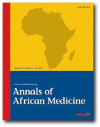
|
Annals of African Medicine
Annals of African Medicine Society
ISSN: 1596-3519
Vol. 9, No. 4, 2010, pp. 213-217
|
 Bioline Code: am10049
Bioline Code: am10049
Full paper language: English
Document type: Research Article
Document available free of charge
|
|
|
Annals of African Medicine, Vol. 9, No. 4, 2010, pp. 213-217
| fr |
Oguntola, A.S.; Adeoti, M.L. & Oyemolade, T.A.
Résumé
Arrière-plan: Appendicite est une condition clinique commune dans le monde entier. Différences entre les incidences, sexe, âge et variations saisonnières ont été signalés largement, avec la rareté des informations du Nigeria. Objectif: Pour évaluer les tendances dans l’incidence et la répétition des variations avec l’âge, le sexe et les saisons de l’année.
Matériel et méthodes: A l’examen des dossiers des patients avec appendicite confirmé traités à la fois l’hôpital d’enseignement LAUTECH (LTH) et le centre médical Abake (AMC), les deux situés dans Osogbo, au Nigéria, entre janvier 2003 et décembre 2008, a été fait. LTH était un centre hospitalier universitaire de 320-lit (avec 100 lits chirurgiens), tandis que l’AMC a été un centre chirurgical de 20 lits. L’âge, le sexe et le mois d’admission de tous les cas histologique éprouvées d’appendicite ont été récupérées et traitées. Analyse a été réalisée à l’aide de simples pourcentages, étudiant t ou essais Chi2, lecaséchéant.
Résultats: Un total de 299 de 321 cas d’appendicite enregistrés pendant la période observée ont été confirmés histologique de deux hôpitaux (69.56% de LTH). Cinquante-deux pour cent étaient les hommes. Il compose 0,94, 1.43 et 1,86% de l’hospitalisation de total en 2004, 2006 et 2008, respectivement. Il y a eu une incidence croissante dans les deux sexes presque dans un modèle similaire. L’âge moyen global a été 25.79 ans (25.94 M et F 25.43 ans) avec 6% inférieur à l’âge de dix ans et 1,3% au-dessus de 60 ans. L’incidence plus élevée dans les mâles et les femelles est survenue dans les décennies de deuxième et troisième, respectivement. Incidences étaient plus élevés pendant la saison des pluies (d’avril à septembre) 68%, P < 0,05), avec des pics de juin à août, lorsque 39,5% des cas présentés.
Conclusion: L’incidence croissante de l’appendicite dans les deux sexes dans cette région peut être due à la modification apportée à un mode de vie occidental. La répartition par âge a une tendance semblable dans les deux sexes et 87% sont 40 ans ou moins, bien que l’incidence est légèrement plus élevé chez les hommes. Prévalence plus élevé d’infection et d’allergènes de pollens dans la saison des pluies pourrait contribuer à une fréquence plusélevée de l’appendicite.
Mots Clés
Répartition par âge appendicite, incidence, variations saisonnières, distribution de sexe
|
| |
| en |
Appendicitis: Trends in incidence, age, sex, and seasonal variations in South-Western Nigeria
Oguntola, A.S.; Adeoti, M.L. & Oyemolade, T.A.
Abstract
Background : Appendicitis is a common clinical condition worldwide. Differences in incidences, sex, age, and seasonal variations have been reported widely, with paucity of information from Nigeria.
Aim : To assess the trends in incidence and pattern of variation with age, sex, and seasons of the year.
Materials and Methods : A review of the records of all patients with confirmed appendicitis treated in both the LAUTECH Teaching Hospital (LTH) and the Abake Medical Center (AMC), both situated in Osogbo, Nigeria, between January 2003 and December 2008, was done. LTH was a 320-bed University Hospital (with 100 surgical beds), while AMC was a 20-bed surgical center. The age, sex, and month of admission of all the histologically proven cases of appendicitis were retrieved and treated. Analysis was done using simple percentages, Student t or Chi-square tests, where applicable.
Results : A total of 299 out of 321 cases of appendicitis recorded during the observed period were confirmed histologically from both hospitals (69.56% from LTH). Fifty-two percent were males. It made up 0.94, 1.43, and 1.86% of the total hospital admissions in 2004, 2006, and 2008, respectively. There has been an increasing incidence in both sexes almost in a similar pattern. The overall mean age was 25.79 years (M 25.94 and F 25.43 years) with 6% below the age of ten and 1.3% above 60 years. The highest incidence in males and females occurred in the second and third decades, respectively. Incidences were higher during the rainy season (April to September) 68%, P < 0.05), with peaks from June to August, when 39.5% of all cases presented.
Conclusion : The increasing incidence of appendicitis in both sexes in this region may be due to the change to a Western lifestyle. The age distribution has a similar pattern in both sexes and 87% are 40 years or less, although the incidence is marginally higher in males. Higher prevalence of infections and allergens from pollens in the rainy season could contribute to a higher incidence of appendicitis.
Keywords
Age distribution, appendicitis, incidence, seasonal variation, sex distribution, trends
|
| |
© Copyright 2010 Annals of African Medicine.
Alternative site location: http://www.annalsafrmed.org
|
|
